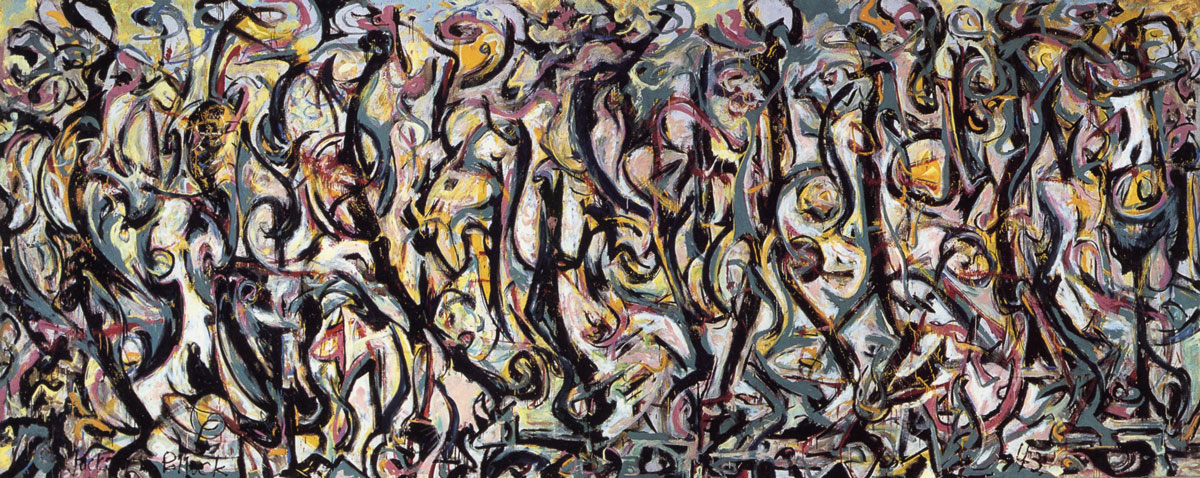ART-PRESENTATION: Jackson Pollock-Mural
 Jackson Pollock was the leading force behind the Abstract Expressionist Movement in the art world. During his lifetime, Pollock enjoyed considerable fame and notoriety. Jackson Pollock’s greatness lies in developing one of the most radical abstract styles in the history of modern art, detaching line from color, redefining the categories of drawing and painting, and finding new means to describe pictorial space.
Jackson Pollock was the leading force behind the Abstract Expressionist Movement in the art world. During his lifetime, Pollock enjoyed considerable fame and notoriety. Jackson Pollock’s greatness lies in developing one of the most radical abstract styles in the history of modern art, detaching line from color, redefining the categories of drawing and painting, and finding new means to describe pictorial space.
By Efi Michalarou
Photo: Columbia Museum of Art Archive
Jackson Pollock’s “Mural” painting, which was immediately recognized as a turning point for American art, is on presentation at the Columbia Museum of Art. The work catapulted the artist into the spotlight, brought out the experimentation of Abstract Expressionism, and broadened the spectrum of modern art. The exhibition features the signature work, as well as scientific research about it and its creation myth. When Pollock painted “Mural”, he redefined not only the limits of his own abilities but also the possibilities of painting. Pollock’s innovation provided a new direction for artist – he had combined the method of easel painting and an abstract style into the large scale of the traditional mural. In 1943, Pollock had recently come to the end of a period working for the Federal Art Project, and was working at the Museum of Non-Objective Painting (later the Solomon R. Guggenheim Museum). The talent displayed by his small early paintings was recognized by Howard Putzel, Peggy’s Guggenheim’s secretary-assistant them. Putzel had urged Guggenheim to give Pollock a project that would unleash the force he perceived in Pollock’s smaller-scaled easel paintings. For her part, Guggenheim was eager to present in her home a symbol of support for the new American art she was beginning to champion in her gallery. The choice of subject was to be his, and the size to cover an entire wall. At the suggestion of Guggenheim’s friend and advisor Marcel Duchamp, it was painted on canvas, not the wall itself, so it would be portable. Pollock signed a gallery contract with Guggenheim in July 1943. The terms were $150 a month and a settlement at the end of the year if his paintings sold. He intended to have the mural done by the time for his show in November. However, as the time aproached, the canvas for the mural was untouched. Guggenheim began to pressure him. Pollock spent weeks staring at the blank canvas, complaining to friends that he was “blocked” and seeming to become both obsessed and depressed. Finally he painted the entire canvas in one frenetic burst of energy around New Year’s Day of 1944 – although the painting bears the date 1943. Pollock told a friend, years afterward, that he had had a vision: “It was a stampede…[of] every animal in the American West, cows and horses and antelopes and buffaloes. Everything is charging across that goddamn surface”. As soon as the canvas was dry to the touch, Pollock broke down the stretcher, rolled the canvas, and transported both to Guggenheim’s townhouse. Some accounts have said that the painting was too long for the space by almost a foot, and when Pollock discovered this he became quite hysterical. Marcel Duchamp and another artist were said to have cut eight inches from one end before it was installed. However, close examination by numerous experts over the years has revealed no evidence of this. Where Pollock’s early works were dark interpretations of Thomas Hart Benton’s figurative Regionalism, “Mural” displays an abstract, expressionist vigor. There are many influences from Pollock’s life and studies present in Mural – Benton’s energetic rhythms, the swirling colors of the American artist Albert Pinkham Ryder, and even the harsh blacks of the Spanish Baroque artist El Greco. The work of the Mexican muralists Diego Rivera inspired him, as did the abstraction bordering on the figurative that originated with the artist to whom Pollock owed the most, Pablo Picasso. We can also see influences from his Jungian psychoanalysis, from the Native American art he had seen as a child, and from the surrealist technique of automatism, which attempted to abandon conscious control in order to allow the unconscious mind to guide the hand.
Photo: Jackson Pollock, Mural, 1943, Oil and casein on canvas, 247 x 605 cm, ), Gift of Peggy Guggenheim, 1959.6, reproduced with permission from the University of Iowa
Info: Columbia Museum of Art, 1515 Main Street, Columbia, Duration: 5/12/18-19/5/19, Days & Hours: Tue-Fri 11:00-17:00, Sat 10:00-17:00, Sun 12:00-17:00, www.columbiamuseum.org
